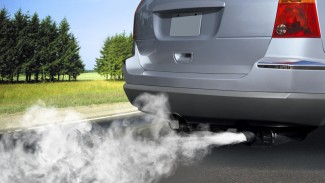The transportation sector offers the greatest potential to slash greenhouse gas emissions through electrification— more even than buildings or industry, according to a recent ACEEE study and four other reports.
Research increasingly cites the electrification of vehicles, buildings, and factories as a key strategy for cutting greenhouse gas emissions and addressing climate change (e.g., see here). In a recent report, ACEEE found that electrification accounted for 35% of the emissions reductions that would come from halving US energy use with energy efficiency measures. Transportation delivered the lion’s share of electrification’s emissions cuts — a whopping 72%.
Other studies have also estimated the electrification opportunity in major sectors of the economy, identifying transportation as having the largest potential. This consensus finding underscores the need to emphasize transportation, notably electric vehicles, in electrification efforts.
Three of the studies look at greenhouse gas emissions reductions from electrification, finding that transportation accounts for 44-72% of the total emissions reduction. Two other studies look at electrification in terms of increased electric load, with transportation accounting for 55-80% of the impact. Transportation electrification includes both electric passenger vehicles and electric medium and heavy trucks; in the ACEEE study, two-thirds of the transportation opportunity is in light vehicles and the other third is in medium and heavy vehicles.
Electrification opportunities in buildings and industry are also substantial and worth attention. Across the five studies, industry accounted for about one-fifth of the impact and the commercial and residential sectors for about one-tenth each. Results by study are illustrated in the figure below, with further details in a table below.
Allocation of Electrification Impacts by Sector in Five Studies
In considering these figures, bear in mind that these are all national averages, and in some local areas the relative opportunity between sectors will vary.
Efficiency and electrification
Energy efficiency and electrification can often happen in tandem, because electric vehicles, heat pumps and industrial electro-technologies (e.g., induction heating and ultraviolet curing) are often more efficient than conventional equipment. In addition, energy efficiency can and should be used to shrink loads, reducing needed investments at both the customer level (e.g., a smaller heat pump generally costs less than a large one) and the grid level (e.g., with lower loads, the need for transmission and distribution enhancements is reduced).
Differences among the studies
While results across the five studies are broadly similar, several studies have outlier values that are worth exploring. For example, the Natural Resources Defense Council (NRDC) estimates a particularly high opportunity in the residential sector, because it assumes that by 2050 nearly all homes will be electrified (95%). It also credits electrification first before considering energy efficiency, showing a larger electrification share than if loads are first reduced with energy efficiency. The National Renewable Energy Laboratory (NREL) is particularly low on the industrial opportunity because, given the complexity and more limited understanding of electrification opportunities in industry, it took a conservative approach on which processes could be electrified. And its residential percentage is lower than that in the other studies, because it looked at changes in electric loads and includes use of heat pumps to replace electric resistance heat, which reduces electricity use while saving energy and preventing emissions from power generation.
Despite their differences, all of these studies find a substantial opportunity to reduce emissions through electrification, particularly in the transportation sector. Any by combining energy efficiency and electrification, the benefits can be magnified. As our Halfway There study found, efficiency, including substantial electrification, can halve US energy use and greenhouse emissions by 2050.
Detailed Results: Percentage of Electrification Potential by Sector and Study
Sources: NRDC, EPRI, NREL, RMI, ACEEE.






